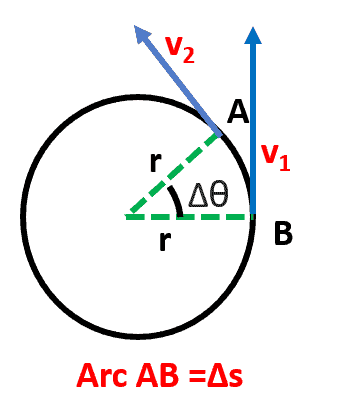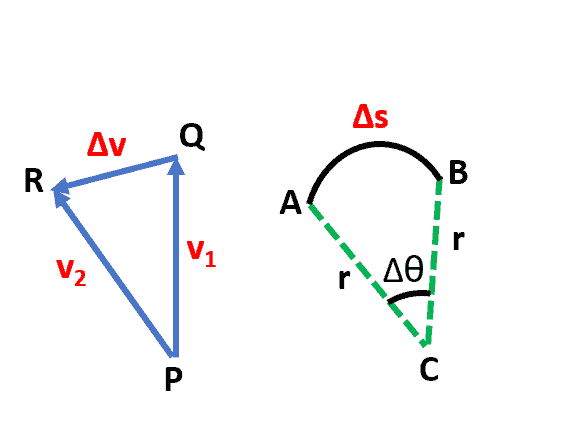Centripetal acceleration is the acceleration experienced by a moving body in a circular path. Its direction is towards the centre of the circle. Keep reading to know more about the definition of centripetal acceleration and the derivation of the relation.

Table of Contents
What is Centripetal Acceleration?
For a moving body traversing a circular path, the acceleration produced by a centripetal force is called centripetal acceleration and is denoted by “ac”. It is directly proportional to the square of the velocity of the body and inversely proportional to the radius of the circle. The direction of this acceleration is radially towards the centre of the circle.
Derivation of Centripetal Acceleration Relation
Consider an object moving in a circular path at a constant speed (v). The figure below shows the direction of the instantaneous velocity at two points, A and B. The change in velocity is Δv and the direction is towards the centre of curvature. Since ac = Δv/Δt, the acceleration is also towards the centre. Because Δθ is very small, the arc length Δs is equal to the chord length Δr for small-time differences.


Both the triangles ABC and QPR are isosceles triangles (two equal sides). Using the properties of two similar triangles, we obtain
Δv/v=Δs/r (Magnitude of vector v1= magnitude of vector v2 = v)
Δv = v Δs/r (Since acceleration is Δv/v, dividing eq by Δt)
ac = Δv/Δt = v Δs/rΔt
Δs/Δt = Magnitude of velocity (Definition of velocity)
ac = v2/r
What is the Centripetal Force?
A centripetal force is a net force that causes an object to move in a circular path.
According to Newton’s first law of motion, a body continues to move in a straight line with uniform velocity, if no external force acts on it. As the velocity of a body moving in a circular path changes continuously, a net force is required to keep the body in a circular path.
From Newton’s second law
ac = Fc/m
ac= v2/r (acceleration equation derived earlier)
Fc=mv2/r
It depends upon the following factors
- The velocity of the body
- The radius of the circular path
- Mass of the body

Examples of Centripetal Acceleration
Some examples of centripetal acceleration are as follows:
- The moon revolves around the Earth. The gravitational force of the earth provides the necessary force.
- The gravity of the earth provides the necessary force to a satellite revolving around the sun.
- A runner going around an oval track field
- A car turning a corner/going around a roundabout.
- Rollercoaster doing a loop
- Clothes inside a washing machine.
- In the whirling of stone, due to tension in the string, an acceleration acts towards the centre.
Advantages of Centripetal Acceleration
Centripetal acceleration has several advantages in various fields of science and engineering. Here are some of the key benefits:
- Improved safety: In amusement park rides and other similar attractions, centripetal acceleration is used to create thrilling experiences for visitors. The use of centripetal acceleration ensures that the riders remain safely in their seats, even at high speeds and along sharp turns.
- Better control: In aircraft, centripetal acceleration is used to control the aircraft’s trajectory and keep it on course. Pilots can control the aircraft’s speed and direction by applying centripetal forces, which helps to maintain stability and improve safety.
- Increased efficiency: In industrial processes, centripetal acceleration is used to separate heavy and light particles, such as in centrifuges. The high speed and direction of the centrifugal forces allow for quick and efficient separation, which can save time and increase productivity.
- Enhanced scientific understanding: Centripetal acceleration plays an important role in the study of celestial mechanics and planetary motion. Scientists use the principles of centripetal acceleration to understand the movements of planets, moons, and other celestial bodies, and to make predictions about their future movements.
Overall, centripetal acceleration offers a range of benefits across multiple fields, and its use helps to improve safety, increase efficiency, and enhance our scientific understanding of the world around us.
Important Definitions
Velocity Time Graph
A velocity-time graph illustrates the speed and direction of an item over a certain time period. Velocity-time graphs are another term for speed-time graphs. The vertical axis of a velocity-time graph represents an item’s velocity. The time since the beginning is shown on the horizontal axis.
Linear Acceleration
Linear acceleration occurs when the velocity of an object moving in a straight line increases or decreases over time. Acceleration can be positive or negative depending on whether the velocity is increasing or decreasing. In layman’s terms, linear acceleration is the rate of change in velocity without a change in direction.
Angular Displacement
Angular displacement is defined as the smallest angle between the starting and end positions of an object moving in a circular motion around a fixed point. It is a vector quantity, which implies that it has a magnitude and a direction.
Uniform Circular Motion
Uniform circular motion is described as the constant-speed movement of an object in a circle. An object in uniform circular motion moves at a constant pace. Despite this, it is accelerating as a result of its change of direction. The acceleration is pointing inwards.
Linear Motion
Linear motion (also known as rectilinear motion) is a one-dimensional motion along a straight line that can be represented mathematically with only one spatial dimension. Linear motion is defined as movement along a straight path, whereas nonlinear motion is any movement that is not in a straight line. Linear motion can be both uniform and non-uniform.
Bottom Line
This article explains the concept of centripetal acceleration along with daily life examples.
It also includes the derivation of the relation of centripetal acceleration and the concept of centripetal force. We hope after reading the article, you have a better understanding of the factors involved in a circular motion. If you have any questions regarding this topic, feel free to post a comment.
Numerical Problems-Centripetal Acceleration
Centripetal acceleration is a type of acceleration that is directed towards the centre of the circular path of an object undergoing uniform circular motion. The numerical problems associated with centripetal acceleration involve calculating the magnitude of this acceleration using different physical quantities such as the speed of the object, the radius of the circular path, and the time taken to complete one revolution. Here are some common examples of numerical problems involving centripetal acceleration:
- Given the speed of an object moving in a circle of radius r, calculate its centripetal acceleration:
a = v^2/r, where v is the speed of the object and r is the radius of the circular path.
- Given the radius of a circular path and the time taken to complete one revolution, calculate the centripetal acceleration:
a = (4π^2r)/T^2, where T is the time taken to complete one revolution and r is the radius of the circular path.
- Given the mass of an object moving in a circle of radius r, calculate the minimum speed required for it to move without falling off:
v = √(g*r), where g is the acceleration due to gravity and r is the radius of the circular path.
Frequently Asked Questions
1. What is a polygon and Is a circle a polygon?
A polygon is not the same as a circle. From end to end, a polygon is a closed form on a plane made up of a finite number of linked line segments. Because a circle is curved, it cannot be made from line segments and so does not meet the conditions for becoming a polygon. Check out the full article “Is the circle a polygon?”.
2. Can displacement be negative?
Since displacement is a vector quantity that depends on magnitude and direction, it can be negative. The negative symbol just denotes the direction. Please refer to the full article “Can displacement be negative?”.
3. Can force be negative?
Since force is a vector quantity that depends on magnitude and direction, it can be negative. The negative symbol just denotes the direction. Please refer to the full article “Can force be negative?”.
4. Negative work?
Work can be negative if the applied force is directed in the opposite direction as the displacement of the moving item. Please refer to the full article “Can work be negative?”.
5. Can kinetic energy be negative?
Kinetic energy can never be a negative quantity. It is never less than or equal to zero.
A moving object’s kinetic energy equals one-half the product of its mass and the square of its velocity.
Because an object’s mass can never be zero, the square of velocity results in a positive answer.
Kinetic energy, as a result, can never be negative.
Please refer to the full article “Can kinetic energy be negative?”.
6. Momentum equation?
The momentum equation is simply the product of a moving object’s mass (m) and velocity (v).
When an object moves and has mass, it has momentum.
The word “momentum of a body” refers to the amount of motion that a body has as a result of its mass and velocity. It is a quantifiable number because if an item moves and has mass, it has momentum.
7. Dampled oscillation?
A damped oscillation is one that gradually fades away with time. A swinging pendulum, a weight on a spring, and a resistor-inductor-capacitor (RLC) circuit are all examples.
The term “undamped oscillations” refers to oscillations that have not been dampened.
8. crest of a wave?
The crest of a wave is the section of the transverse wave above the mean level. The trough of a transverse wave is the segment of the wave below the mean level. The wavelength is defined as the distance between two consecutive crests or troughs.
9. What is displacement in physics?
Displacement in physics is a vector with a length equal to the shortest distance between the initial and final positions of a moving object.
10. What is relativistic kinetic energy?
The relativistic kinetic energy equation indicates that when an object’s velocity approaches the speed of light, its energy approaches infinity. As a result, accelerating an item over this limit is impossible.
It is the acceleration produced by a centripetal force is called centripetal acceleration and is denoted by “ac“. It is directly proportional to the square of the velocity of the body and inversely proportional to the radius of the circle. its direction is radially towards the centre of the circle.
It is the rate of displacement of a moving object. In other words, it is the speed at which an object moves in one direction. Its scalar magnitude is the speed of motion.
More Links
Paramagnetic Materials
Longitudinal Waves| Physics
Gamma Decay| Radioactive Decay
Energy-The Ability to do Work
Electric Field Units & Definition
Surface Charge density
- BCl3 Lewis Structure in four simple steps - November 1, 2023
- PH3 Lewis Structure in four simple steps - October 8, 2023
- PF3 Lewis structure in four simple steps - September 24, 2023



